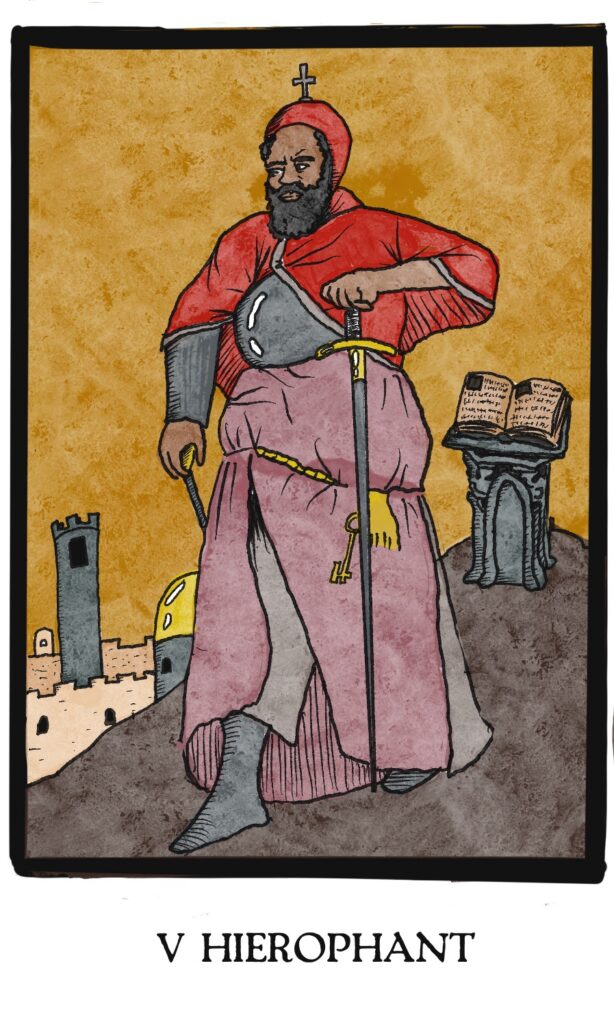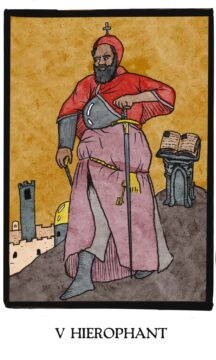
After following the river for a time, the Fool entered a vast city made of towers and domes, with symbols at the tops of each one. Some of the spires were made of wood or gold, while others were stone domes. The city, too, was made of stone, and it was hot there, even when the Fool chose to walk on the shady side of the street. The city sloped up to a large building in the middle. All the roads seemed to lead there, so the Fool went there too.
The building turned out to be the church, the bank, the government, and the university all in one. When the Fool entered, he was faced with the Hierophant, a very well-dressed man standing at a lectern with a large book open on top of it. The Hierophant was dressed as a pope, minister of the treasury, vizier, and dean of the colleges. He had a cross tucked under his arm and his other hand was resting on an ornate sword. At his side hung two keys. He wore a crown festooned with religious idolatry.
I am Institution, the Hierophant said as the Fool walked in. People cannot stay safe without me and my laws and my rules. The Hierophant sounded almost defensive of his existence.
The room they stood in opened up onto a great balcony, and from up there the Fool could see the whole city. White fabric whipped around in the hot wind that blew over the room, which was full of books, scrolls, and instruments of learning. The Fool saw telescopes and a sextant. He saw a skull.
I am the bridge between the heavens and earth, said the Hierophant. I am the boundary between the Gods and men. I am a shaman, but cities and civilization have asked more from me. They also have asked less of my original purposes. The Hierophant waved his arm over his books of law and theology. I have been asked to make sense of God from the direction of what man has written.
The Fool could see jail cells across the way from where they stood. He thought he could see men in there. The sun beat down on his neck, so he moved back into the shade of the walls. The Hierophant followed, and offered him a seat, and a drink of wine from a silver chalice. The Hierophant seemed angry about his position, but materialistically he appeared to be very well off. His clothes were nice. His buttons were made of whalebone and gold, and he had rings with jewels in them on most of his fingers. His scarf was pure silk. His fork and knife were silver, and his plates were gold. Running institutions was making this poor shaman rich.
The Fool understood this archetype the most. This was what his world was like. He was having the same reaction to the Hierophant as he had with the Magician and his pentacle coin. The Fool was trying to leave all of this behind, and yet the journey had led him here, so there must be a lesson to learn.
The next day, the subjects who had visited the Emperor were to come in, and the Hierophant was to take the Emperor’s decision or advice and implement it. Sometimes this job was very easy, and the Hierophant just made new laws on paper and filed them: it was written, so it is so. Other times, the Hierophant had to interpret the Emperor’s wishes and needed to study a subject in order to make the wish come true. The Fool saw the Hierophant as a student of many subjects, so it was never hard for the Hierophant to find the answers he was looking for. The Hierophant studied theology, philosophy, math, biology, history, chemistry, psychology, esoterism, astronomy, geology, political science, physics, art, alchemy, rhetoric, and many more subjects to stay on top of implementing the will of the Emperor and the people. When the Fool first arrived, he thought the Hierophant the ruler, but now he saw that the Hierophant was the servant of the land.
The Hierophant tried to get the Fool to study some of the subjects, but the Fool just couldn’t pay attention. The Hierophant remembered teaching the Fool these things before, and sometimes the Fool would seem to get it, but then the Fool would return, empty-headed. The Fool wanted to be smart. He wanted to absorb the knowledge the Hierophant was passing on to him, but when a question was asked, the Fool couldn’t even regurgitate any information for an answer.
A Hierophant can also be corrupt with absolute power and money, the Hierophant once commented, but I am the archetype of the profession and idea, so I am merely a tool. You can’t rely on other people’s knowledge, the Hierophant continued, but to be a student yourself.
Decades passed – or maybe it was a few hours – and the Fool grew frustrated and bored. He didn’t want to sit at a desk doing math equations, or reading about Aristotle. He wanted to wander. The Hierophant didn’t try to persuade the Fool to stay; in fact, he supported the Fool’s need to journey on. It would be good for the Fool to experience things instead of just reading about them. Some things in life can only be taught through participation.
So as the sun rose from the east – or maybe it was the west – the Fool left the city on the hill. He wandered down a boulevard lined with hanging flower baskets. He walked by dusty buildings with old ladies standing in the doorways sweeping, forever sweeping. Men sat in squares around fountains playing chess and backgammon and smoking cigarettes. He didn’t see any children, but maybe they were in school.
The Fool walked out a gate and into a forest on a dirt road. Soon the trees grew thick and almost formed a wall on either side of the road. From the balcony above, the Hierophant watched the Fool walk out of the city and into the wood. He hoped the Fool would find something to hold on to. He was there when they made the Fool, after all. He’d been the foreman of the operation. There was so much potential that they had put into the Fool.
He sighed and went back to writing policy.
